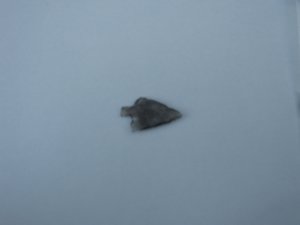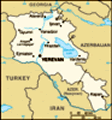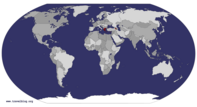Advertisement
Published: August 7th 2010

 Obsidian Point
Obsidian Point
A quintessential Early Bronze Age obsidian point-- probably more for hunting that warfare, we found it in one of the storage pits in T27.Well into Week 5, I'm finally getting around to writing about Week 4-- life on Project ArAGATS is growing hectic because we have less than a week left in the field, and so much left to do-- not to mention final trench reports to write, artifacts to catalog, C14, and dendrochronology samples and ceramics to pack so they can be shipped back stateside for analysis... but all is good-- for archaeological excavations (and academics in general...) this last minute cramming is nothing unusual. In any case, I'm getting ahead of myself, and details about Week 5 will have to wait until my next entry.
After a wild week 4 in T27; with the final count at forty-four complete (though some fragmented) ceramics removed, two bronze arrowheads, two obsidian arrowheads, and over twenty grinding stones and mortars, Sunday's field trip was a welcome day away from the trench. This time Ian led the trip which spanned sites from the Early Iron Age (c. 8th century BC) to the early Middle Ages. First stop: Erebuni (ancient name: Argishtihinili) and the ancient capital of the Urartian Empire, an Iron Age kingdom which controlled most of modern day Armenia, parts of northern Iran, and eastern

 Calm after the Storm
Calm after the Storm
After one of the many thunderstorms passed over our house a double rainbow emerged. Perhaps a bit late as we had already uncovered the 44 pots, but the luck was welcomed nonetheless.Turkey. It was built by Argishti I sometime between 780 and 760 BC as the central citadel for his kingdom, and as Adam has argued in his dissertation and subsequent books, the construction of this fortress/palace was as much a way for Argishti to convey his overwhelming power and supremacy in the region, as it was a strategic position for a fortress/political capital. In many ways, the inscription that Argishti left in the cornerstone of the small temple inside the fortress walls says it all: "For the greatness of the god Khaldi, Argishti, son of Menua speaks: I built a majestic fortress, I gave it a name from my own: Argishtihinili. The earth was wilderness; nothing was built there; out of rivers I built four canals, vineyards, and the orchards were divided, I accomplished many heroic deeds there. Argishti, son of Menua, powerful king, great king, King of the Kingdom of Biainili, ruler of the city of Tushpa." The site itself sits on a hill above the modern city of Yerevan, and has been used in modern political machinations to argue that Yerevan (and Erebuni) is the longest continuously occupied capital in the world-- but this is pure modern politics:

 The Modern Erebuni
The Modern Erebuni
The view from the top of Erebuni reveals what Argishti I could never have imagined-- out of the picture to the left, a major nuclear power plant... and one of the many Yerevani promenandes down the center. How do you explain automobiles and nuclear fission to an Iron Age king? You're guess is as good as mine.it would be as if New York City claimed it was 700 years old since Native Americans had established a fishing village on Manhattan island in the 1300s. In this way, visiting Erebuni was a lesson in how the past can be used as a political tool in the present. At breakfast that morning Adam warned us that Erebuni is the "Knossos of Armenia" (see Blog #2 from last year) -- meaning the site itself is irresponsibly reconstructed and what the visitor sees there today is almost certainly not the way the site would have looked when it was occupied. Again, this was done for a modern political reason: during the 1970s, in an effort to tie into ancient roots, the Soviet government of Armenia rebuilt the monument as imposing and striking as possible and out of concrete (a material which did not exist during the Uratian period). What is worse, the site itself has really fallen into disrepair, with weeds growing everywhere and tons of graffiti all over the place. Nonetheless, it's a magnificent site, and even to have the chance to get a flawed impression of what it must have been like during the Early Iron Age was

 Zvartnots
Zvartnots
The ruins of the ancient cathedral post earthquake-- it was a circular chruch, and is reminiscent of a pagan temple. amazing. Nevertheless I still left the site thinking about Armenian archaeology in the same way I think about the use of the past in Cyprus, Crete, and even in the US: if only countries invested some time and money into using their archaeological resources as well informed tourist draws, not only would locals and visitors gain a better appreciation for the ancient people and the world they lived in, but the countries would tap into a new and profitable economic vein. But, that's probably just me up on my soap box.
After Erebuni, we headed off to Echmiadzin, the Holy See of the Armenian Apostolic Church, a type of Christianity which has its roots in the Orthodox movement like the Russian and Greek Orthodox churches. The cathedral there was beautiful and while not breathtaking like the Vatican, it was fascinating to see the Holy See of another Christian sect. Outside the church the former Catholicos (the equivalent of the Pope for the Armenian Church) are buried, and while the church itself is remarkably small for such an important religious center, the inside of it was more ornate that any church I'd been in before. Strangely the church had very little

 Brews, then and now
Brews, then and now
Cilikia, an Armenian beer in my hand and the ancient beer jug from T27 in Conner's. Looks like he's got the better deal. In any case, we're unsure how drinking rituals may have worked since the one straw hole makes it conducive for only one person to drink at once. But that is one gigantic beer bottle... room for communal worship (that is, there were no pews-- a very stark contrast to the churches I've grown used to in the US). Instead, the cathedral vault is filled with places to light candles and pray. The altar sits at the front of the church but up on a platform and very obviously separated from the congregation. I imagine this reflects a greater emphasis on the separation between the lay folk and the clergy-- and I found this a bit sad and somewhat Medieval. In any case, the architecture of the church was beautiful, though I didn't take any pictures-- I never feel comfortable photographing the inside of a place of worship unless I know it won't be offensive. Instead of the marble and stone vaults I'm used to associating with cathedrals (like the Vatican, St. Patrick's or Westminster), the cathedral at Echmiadzin is decorated mostly by very intricate wooden columns and roofing beams, and while the Armenian Apostolic Church does not worship icons like the Greek and Russian Orthodox sects, they do include some in the decoration of the church.
After exploring the church for a bit we headed to the small church museum which is held in

 Bronze Arrowhead
Bronze Arrowhead
One of the Late Bronze arrowheads from T27-- and probably associated with the destruction of the city-- rather than hunting.a suite of rooms behind the altar. There we were able to see some of the church's prized possessions including the robes and staffs of prior Catholicos (Catholicoses? Catholici?) as well as a very small piece of Noah's Ark, the "spear" of the Roman soldier who pierced the side of Jesus when he was on the cross, plus relics from Saints Thaddeus, Peter and Andrew, and a piece of the Cross itself. One of two guides stationed in the small museum gave us a fifteen minute tour, explaining that while many places around the world claim to house the spear of the Roman soldier who stabbed Christ, this is the real one, and that the small piece of Noah's ark was collected by Saint Thaddeus during the Middle Ages, but that the ark had disappeared from the slopes of Mt. Ararat after because God had decided no one should need proof as to whether it exists or not. She was unaware (or chose to ignore the fact) that the spear was certainly not of the Roman style, and it seems rather convenient that the Ark disappeared just after a piece of it was taken for the Armenian church. All in

 Erebuni
Erebuni
Concrete, concrete and more concrete hold up the walls of the reconstructed Erebuni. Virtual reality is a much better way to go, in my opinion...all, however, Echmiadzin was an interesting glimpse into the Armenian church.
Next we stopped at Zvartnots, the first Christian cathedral in Armenia created in the 4th century by the founder of the Armenian Apostolic Church, Saint Gregory the Illuminator. On a mission to spread the Word of God, he was imprison by the Armenian king, Trdats I in 301 AD and spent years in an underground dungeon. Eventually, however, his perseverance was successful and he convinced King Trdats I to make Christianity the first national religion of Armenia. By all accounts, Armenia was the first country to accept Christianity as the national religion in 301 AD-- Constantine I, the Roman emperor, followed suit 12 years later with the Edict of Milan. In any case, Zvartnots collapsed in the 10th century, after a major earthquake. It was a unique construction since it was a circular cathedral, and even seeing the remains of the site was worthwhile. It was 105° F and we were all pretty exhausted-- especially since we needed to walk about 3/4 of a kilometer before crawling, through the fence, into Zvartnots, and then having to pay to visit (even though the main gate was locked shut...). Needless to

 A Roman Spear...
A Roman Spear...
The spear which supposedly pierced the side of Christ. But typologically not anywhere close to a 1st century AD Roman spear. Compare for yourself: http://www.romancoins.info/MilitaryEquipment-spear.htmlsay we spent less time exploring Zvartnots than one would like before heading back to the car and our return journey to Aparan.
I hesitate to say that the work in T22 and T27 has been slow (because it hasn't) but things have definitely slowed down since last week. However, in the upper part of T27 we have exposed two pits : both of which are small by Late Bronze Age standards but interesting nonetheless. It's puzzling that they are so small: Adam and I have had close to ten different discussions on why the Late Bronze Age people decided it was a good idea to expose their pottery/storage jars (and forty-four of them!) and yet bury close to nothing in there pits. Wouldn't it have been more intelligent to bury their storage vessels and leave more useless, day-to-day objects on the floors? Anyway, the analysis of two large, intact pots from T27 have come back: one (the larger) was for beer storage or fermentation and the smaller seems to have been for wine; in any case it is clear that the people who lived in my trench believed that "it's 5 o'clock somewhere..."
While T27, and especially the clay

 Echmiadzin Cathedral
Echmiadzin Cathedral
No pictures from the inside, but this one shows one tower of the church from the outside. It's in great shape for being built in the 7th century...platform (hypothesized to be a living surface) will have to wait until next year and the opening of T30 to the W, to determine it's purpose, we've begun to move east and downslope in order to better understand the terracing/fortification architecture in the downslope parts of my trench. In many ways I am blessed to have Ruben and Adam treat me as a colleague (and respect my opinions and hypotheses)-- and many an Oriental (in Armenia we don't call it Turkish or Cypriot) coffee discussing the various ways ancient people might have used the lines of stone (aka walls) which make up the most downslope portion of my trench. In any case, the architecture itself (in addition to the ceramics in the upper part of the trench) make T27 utterly fascinating-- and have gone a long way to convince me to come back to Armenia next year as long as Lori, Adam, Ruben and Ian will have me.
My experiences in Armenia have been fascinating and wonderful-- and a hardy thanks (and toast, if you happen to have an alcoholic-- or non-alcoholic-- beverage in your hand) are most certainly required for Ruben Badalyan, Lori Khatchadourian, Adam Smith and Ian Lindsey. Without them, none of this incredible research (or my rough-cut blogs) would have be possible. To them, I dedicate both the beer that I'm drinking while writing and my life-changing experiences here. I'd also like to thank Mom, Dad, Greg and Mike for the tremendous support they've shown me in the many years that I've made summer vacations very difficult. Without their support, interest and love my life as an adventurer would be utterly impossible... and of course without them I'd never know I had a little head but a big brain 😉. All my best to those at home; so, so many of you and your support (even if you think I'm digging dinosaurs) has gone such a long way in giving me the courage and resilience to pursue my dreams-- I'm looking forward to sharing my experiences with you all in person in the following weeks.
Hugs and high-fives to all,
Jeff
Advertisement
Tot: 0.057s; Tpl: 0.013s; cc: 10; qc: 28; dbt: 0.0288s; 1; m:domysql w:travelblog (10.17.0.13); sld: 1;
; mem: 1.1mb










Aunt Maggie
non-member comment
Once again, great blog! Have a safe trip home, see you next week!